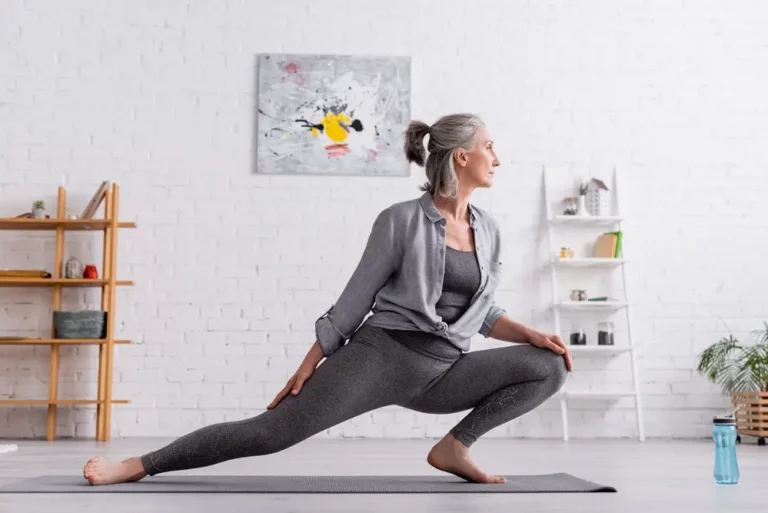Can You Use A Fan Or An Air Conditioner While Doing Yoga?

If you tend to run hot, even the fluid motions of yoga can make you feel like you are about to collapse from the heat. With so many different opinions on the best practices for yoga, you might be unsure if using a fan while doing yoga is OK.
Using a fan while doing yoga will not negatively affect workouts. According to health experts, the ideal temperature for any exercise – including yoga – is between 68 and 72 °F (20 and 22 °C). However, extremely low or high temperatures can pose health risks.
We all know that sweating while doing exercises is good, but if you perspire excessively, it could make your yoga sessions less enjoyable. Below we’ll look at all the reasons why using a fan can be beneficial while doing yoga.
Is It OK To Do Yoga With A Fan?
You don’t have to worry that cooling down would make yoga less effective. If you feel hot and need to cool down, switch on the fan and be as comfortable as you need to be. You can still have a great session even if you sweat a little less.
In fact, it is crucial to keep your body temperature steady while doing yoga because exercising when it is hot can be very dangerous.
Our bodies regulate our core temperatures through a process called thermoregulation; we sweat to cool down when it’s hot. Our bodies have various mechanisms – such as shivering – to produce or retain heat when it is cold.
However, thermoregulation is not aninfallible function; these mechanisms can fail when the human body faces severe temperatures. That is when we need to step in and help our bodies cope with external stresses.
If your body doesn’t cope well with heat, you should be careful to keep your core temperature balanced to avoid heat-related dangers like heat strokes, heat exhaustion, or dehydration. A fan can help you avoid overheating on a hot day while doing yoga.
What Do Experts Say About Hot Yoga?
Yoga originated in northern India millenniums ago; some argue that yoga is meant to be hot, as its original destination is known for sweltering weather. However, no science proves that yoga is more effective in warmer conditions.
According to Livestrong and Gerald Endress (an exercise physiologist), the best indoor temperature for exercising is 70 °F (21 °C). Slightly higher or lower temperatures should be just as effective; just don’t enter the extremes.
Some people who practice yoga believe that Bikram (hot yoga) is more effective than cold (or room temperature) yoga because you sweat more and your body needs to work harder. However, there aren’t many substantial facts to supportthe claim; as explained above, high temperatures can pose certain dangers to the human body.
Bikram is practiced in studios with temperatures of around 105 °F (40.5 °C); this might not sound too bad, but the possible dangers attached to hot yoga were worrisome enough that The American Council on Exercise investigated the practice.
The study found that Bikram can raise core temperatures higher than 103 °F (39 °C), The National Athletic Trainer’s Association along with The American College of Sports Medicine concurred that these are dangerous ranges as heat-related illnesses like heat strokes can happen at 104 °F (40 °C).
However, hot yoga can be beneficial when the instructors know what they are doing. If you decide to practice Bikram, getting the all-clear from a medical professional would be your best way forward.
Indoor Yoga With A Fan Or Outdoor Yoga – Which Is Better?
According to Women’s Health and Eion Finn, yoga is best practiced in the great outdoors with calming scenes and nature sounds. If you feel that the indoor sessions lack more than a fan, perhaps you could give it a breath of fresh air.
Finn provides yogis with the following advice to take their sessions outdoors:
- Look for a nice shaded spot
- The better the view, the better the experience
- Select calming music on mp3 player
- Take something to cover your eyes for savasana
- Stay awhile and read a few chapters of a book
Can You Do Yoga Under An Air Conditioner?
Using a fan while doing yoga is fine, but will an air conditioner be as beneficial? Some trainers use air conditioners when they work out, believing that being comfortable is a great way to maximize your efforts. But what does science say?
According to WebMD, air-conditioned rooms with poor ventilation can cause you to feel ill with prolonged exposure. If you feel sick, it impacts how much effort you put into a session. It can also dehydrate because it removes the moisture from the air – remembers to drink water.
Yoga promotes calmness, but sometimes your meditative state can be interrupted when you feel uncomfortable on hot days; using an air conditioner has been proven to provide better focus.
Keep in mind that lower temperatures can affect how our muscles work. Warm temperatures provide for more flexibility; this means that if your air conditioner is running at 65 °F (18 °C), you may need extra time to warm up your muscles before doing yoga.
Air conditioners have many benefits, but they can also cause some minor health issues that may have a negative impact on your yoga session. However, because sessions only last for about 90 minutes, you should not be as severely affected as someone who sits under an air conditioner all day long.
To lessen the effects an air conditioner can have on your body, don’t run the temperature at the lowest setting all day long. Make sure the filters are routinely cleaned to avoid issues like sinus flare-ups and headaches.
Conclusion
A fan can only enhance your workout if you feel more comfortable in a cooler environment during a yoga session; however, take more caution when using an air conditioner. Remember that exercising in extremely low or high temperatures can harm your health and that hot yoga is no better than regular practices.






